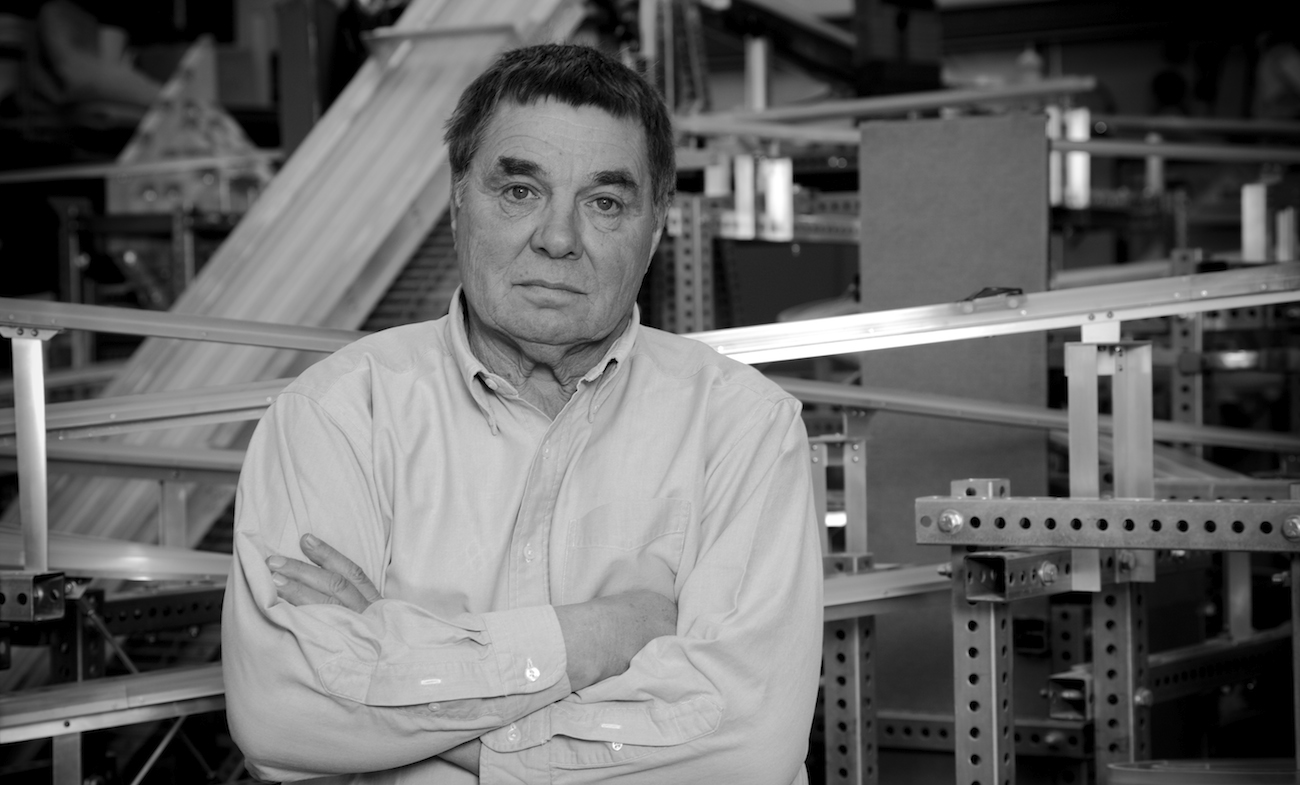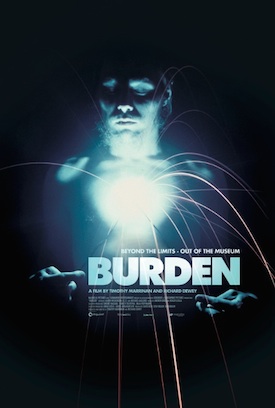 Chris Burden guaranteed his place in art history in the 1970s with a series of dangerous and at times stomach-churning performances. After having himself shot in Santa Ana, confined to a locker for five days in Irvine, and crucified on the back of a VW bug in Venice, Burden reinvented himself as the creator of truly mesmerizing installations and sculptures, from a suspended gigantic flywheel that seemingly spins on its own to an assemblage of illuminated, antique streetlights outside the Los Angeles County Museum of Art called Urban Light, which has become one of Los Angeles’ most photographed and iconic symbols. In the mesmerizing new documentary Burden, directors Timothy Marrinan and Richard Dewey look at the late artist’s work and private life with an innovative and riveting mix of videos of his 70s performances, personal films and audio recordings, footage from his Topanga Canyon studio, and comments from friends, fellow students, colleagues and critics, all peppered with Burden’s iconoclastic musings from throughout the years.
Chris Burden guaranteed his place in art history in the 1970s with a series of dangerous and at times stomach-churning performances. After having himself shot in Santa Ana, confined to a locker for five days in Irvine, and crucified on the back of a VW bug in Venice, Burden reinvented himself as the creator of truly mesmerizing installations and sculptures, from a suspended gigantic flywheel that seemingly spins on its own to an assemblage of illuminated, antique streetlights outside the Los Angeles County Museum of Art called Urban Light, which has become one of Los Angeles’ most photographed and iconic symbols. In the mesmerizing new documentary Burden, directors Timothy Marrinan and Richard Dewey look at the late artist’s work and private life with an innovative and riveting mix of videos of his 70s performances, personal films and audio recordings, footage from his Topanga Canyon studio, and comments from friends, fellow students, colleagues and critics, all peppered with Burden’s iconoclastic musings from throughout the years.
Danny Miller: This film blew my mind. I knew about the artist who made the iconic Urban Light and Metropolis 2 sculptures at the L.A. County Museum of Art, and I knew about the guy who had once had himself shot for an art performance, but I had no idea that those two guys were the same person! After watching the film, I wondered if you thought Chris Burden ever felt uncomfortable by his later status which was so different from his earlier “bad boy” place in the art world.
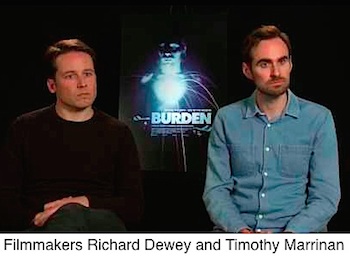 Timothy Marrinan: I really don’t think he did. As you say, those later public sculptures that have been embraced by the public seem very different from his early work, but I think for him it was a kind of gradual, organic process. He did a lot of things over those 40 years and I think he viewed those early performances as sculptures in their own right — just ones that used his body as the raw material. The transition to making actual physical sculptures was natural for him. And frankly, I think it gave him a lot of pleasure to see how his very large-scale sculptures were embraced by people of all ages.
Timothy Marrinan: I really don’t think he did. As you say, those later public sculptures that have been embraced by the public seem very different from his early work, but I think for him it was a kind of gradual, organic process. He did a lot of things over those 40 years and I think he viewed those early performances as sculptures in their own right — just ones that used his body as the raw material. The transition to making actual physical sculptures was natural for him. And frankly, I think it gave him a lot of pleasure to see how his very large-scale sculptures were embraced by people of all ages.
The two bodies of work seem so different, but you’re right, the throughline is there. And he never seemed to really distance himself from the earlier work, either.
No, and part of our reason for making the film was to trace that journey and take a look at how one thing logically leads to the next.
Richard Dewey: Right. I think for him it seemed like much more of a natural progression than it might to people looking at his career from the outside. There was always this element of asking questions and trying to engage with the audience in some way and to push the boundaries. Those three things were evident in his performances and also his sculptures. It’s just that later on he had more resources available to him and could do bigger, more complex works like you see with Urban Light and Metropolis.
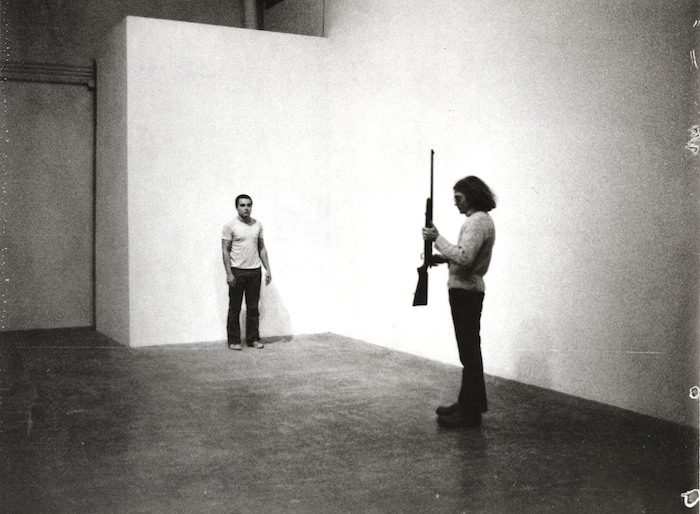
I was surprised at how fascinated I was about his earlier work including the performances that really made some people question his sanity. I might have had a different reaction if I’d been there at the time but looking back, I so admire his artistic intentions and courage even if part of me still thought, “Huh? What the fuck is he doing?”
Timothy: One of the most interesting things we’ve found in talking to people about this film is that even today people have very different takes on Chris’s art. Some people are drawn to the things he was doing later in life and the early stuff isn’t for them, while it’s the opposite for others — they’re less interested in the sculptural stuff but are completely fascinated by the early work. The common denominator is that his art provokes a strong response either way, it’s not the kind of stuff that makes you shrug and not care one way or the other. Certainly back at the time when he was doing his performance work there were a lot of responses from the more conservative art press at the time — people saying it wasn’t art, it wasn’t legitimate, and all that. That view has changed over time and his work is definitely part of art history now, and has proven to be very influential to other artists.
The British art critic, Brian Sewell, is an interesting character in the film. Did you specifically want to include someone with that more critical point of view?
I think he represents a view that was quite widespread at the time — although he may be in the minority now in terms of how performance art is viewed. We wanted to put in a certain amount of critical responses to Chris’s pieces to give people an idea of what people were saying about him, but that wasn’t our primary goal with the film. What we most wanted to do was to bring Chris’s art to a new audience, to put it in the context of the time, and let people have their own reactions to it rather than someone else’s point of view.
Chris Burden doesn’t strike me as someone who would necessarily want to have his whole life featured in a film like this. Did it take a while for him to trust you guys and give the go-ahead for the documentary?
Richard: It started with a magazine article Tim and I wrote about him which he liked. The second step was a short film we made that focused on his art piece called “Beam Drop.” So by the time we went to him and asked to do a feature-length documentary about his life, we’d been around the studio for a long time and had gotten to know how he worked. There was a lot of trust that had already been built at that point.
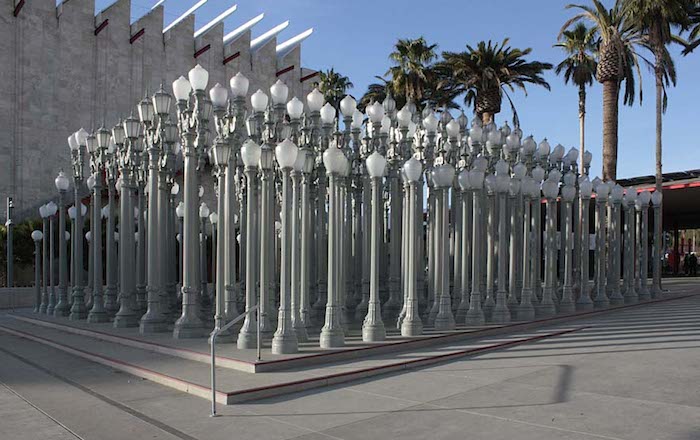
Do you think if he were around today that he’d be here with you promoting the film?
I’d like to think so. He died, sadly, just as we were starting to edit the film, but I think he would have liked it. We tried to treat his life and career fairly and objectively without imparting are own views on his art. We tried to be very even-handed with all the different parts of his life, it wasn’t just focused on the performances or the big sculptures.
Timothy: And we’ve had some nice responses from people who worked with Chris and people who knew him very well. It’s sad that Chris never got to see the film. When he passed away, he still had many ideas in the works and he could have carried on for many more years. That just made us more determined to do justice to his life and work. He led such an interesting life — it made us want to represent him well.
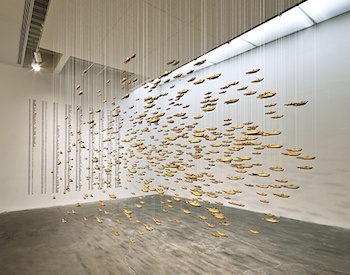 His work seems even more important today with the political climate that does not really support the art world, especially the kind of art that Chris was interested in. Do you think he’d be speaking out about that today?
His work seems even more important today with the political climate that does not really support the art world, especially the kind of art that Chris was interested in. Do you think he’d be speaking out about that today?
His engagement with politics was always very interesting. He did these pieces that were overtly political but they were done in his own way. There was one piece we showed in the film called “All the Submarines in the United States of America,” which is a model of every active sub in the U.S. fleet. Not an obvious way of approaching politics but making strong statements with numbers and letting people draw their own conclusions.

